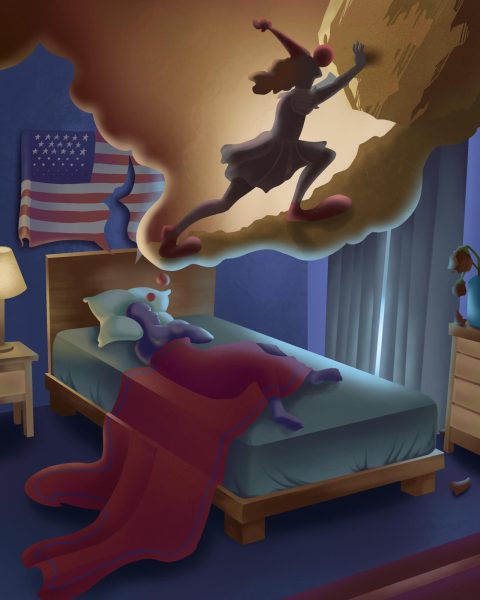Breaking the Stigma
People with mental illnesses often fail to get help because they fear being judged, ridiculed and ostracized.
When I was 10, the scariest place in the world was the one place I couldn’t escape — my mind. It was as if there were a big, dark cloud hovering over me, following me everywhere. No matter what I did, where I went or who I was with, I couldn’t shake the all consuming feeling that I was drowning even though I had all the oxygen in the world to breathe. I cried constantly. The worst part of all, the thing that frightened me more than my worst nightmares ever had, was that I didn’t understand why I was feeling this way. I thought there was no hope. I thought I was crazy. I thought I was all alone.
This is depression, and I am anything but alone.
According to the National Institute of Mental Health, in 2012, approximately 16 million adults in the United States, or 6.9 percent of the country’s adult population, had at least one major depressive episode within that year, making it one of the most common mental illnesses diagnosed in the country.
Despite this, there is still a societal stigma that people with depression and other mental illnesses face. The Western Australia Mental Health Commission defines stigma as a mark of disgrace that sets a person apart. This can cause the patient to experience feelings of shame, blame, hopelessness, distress and reluctance to seek help. The website reports that three out of four people with mental illness have experienced this.
This stigma comes from a variety of sources, one of which is the misrepresentation of mental illness within the media. Last month on March 24, Germanwings flight 9525 was crashed into the French Alps by co-pilot Andres Lubitz, killing all 150 people on board, in an apparent murder/suicide. During the media coverage following the crash, many news outlets, such as Fox News, suggested that depression was to blame for Lubitz’s actions.
In his opinion article, “Could ‘psychotic depression’ have downed Germanwings plane,” Fox News reporter, Dr. Keith Ablow writes, “The fact that co-pilot Andres Lubitz crashed Germanwings flight 9525 into the French Alps, killing 149 people and himself, suggests that, were major depression to blame, it had spiraled down into the worst form: psychotic depression.”
Although Ablow does state that this particular form of depression is extremely rare, he fails to state one basic but very important thing: depression, in its most common form, as well as most other mental illnesses, do not make people murderers. There is no reason to fear someone with depression, bipolar disorder or any other common mental illness. Like many physical illnesses, these conditions are completely treatable and patients can and do live normal lives with proper medication and therapy.
Abigale Varmuth, 31, a stay-at-home mom, has battled depression since she was a freshman in college. She said that when she first began experiencing symptoms she was afraid to share them with her family and her illness went untreated for years which nearly resulted in her losing her life.
“It started when I was 18. I was away at college, on my own for the first time, and I guess that’s a pretty common time for symptoms to start. I remember, at first being sad because my boyfriend and my family were so far away. But then, the stress of making new friends and grades and classes and homework and extracurriculars just piled on. Nothing seemed right, and everything was overwhelming. I was tired and on the verge of tears all the time. But I was afraid to ask for help because of what my family might’ve thought.”
Varmuth said her parents often spoke ill of her cousin with obsessive compulsive disorder OCD when she was growing up.
“They didn’t understand her so I didn’t think they’d understand me, either.
I tried to deal with it on my own for a few years, but it just got worse, especially after my boyfriend and I went our separate ways. Until finally, one night during my junior year, I was in my apartment, alone. I had just failed a midterm, despite trying my best, and that little thing just pushed me over the edge. I was crying uncontrollably, I downed a bottle of vodka and a handful of sleeping pills. I didn’t want to die, not really. I just wanted the sadness and pain to go away, and I thought that was the only way to do it.”
Varmuth said her roommate discovered her lying unconscious on her bedroom floor upon returning home a few hours later.
“She called 911. She saved my life. And I look at my daughters now and I thank God every day she did.”
Varmuth said that she still battles episodes of depression from time to time but she has never once wanted to harm anyone.
“Before I understood my depression and got the help I needed I just wanted to kill the sadness, even if that meant killing me in the process. But I’ve never, ever, not once wanted to harm or kill another person. It’s just ridiculous that people like me are painted that way in the media.”
Varmuth said she was lucky. After her parents discovered what had almost happened, they were very supportive.
“They told me whatever I needed they’d do, which is great. But not everyone is lucky enough to have a supportive family. And I would’ve gotten help much sooner if my parents hadn’t somehow gotten the idea that my cousin was damaged.”
The Guardian reporter and depression patient of 15 years, Matt Haig, said, “Depression is a horrible, potentially life-threatening illness — but the lives it threatens are almost always those of the people who suffer from it. If it does emerge that [the Germanwings crash] was a result of his depression then we need to be able to differentiate between types of depression. Psychotic depression is not the most common kind, or anywhere near it.”
In fact, psychotic depression is only thought to occur in approximately 20 percent of people with major depressive disorder.
However, as important as it is to differentiate between which mental illnesses can make people violent and which usually don’t, it is also important that people are educated about all types of mental illness so no one ever is too ashamed to ask for help.
On June 3, 2013, the White House held a conference on mental health, where President Obama addressed the stigma surrounding mental ilness.
“We whisper about mental health issues and avoid asking too many questions. The brain is a body part, too. We just know less about it. And there should be no shame in discussing or seeking help for treatable illnesses that affect too many people that we love,” Obama said.
Obama went on to discuss the fact that only 40 percent of people with mental illnesses seek treatment. Comparing it to diabetes, he said it would be unacceptable if only 40 percent of people with diabetes sought treatment, therefore illnesses of the mind should be no different.
Tony Nichols, 24, a nutrition major who was diagnosed with bipolar disorder at 13, said that comparing mental illness to physical illness makes sense in theory, but falls short in practice.
“I was told to never discuss my illness, but that was 11 years ago. It’s awesome that mental illness is being talked about more now- that’s the first step to ending it’s taboo. We can compare it to physical illness all we want, though. It’ll never really be the same in people’s minds as long as someone who gets treatment for something like cancer is met with sympathy and kindness and someone who gets treatment for depression or bipolar disorder is called crazy.”
Nichols said that as a nutrition major he has learned that the body and the mind are really a single entity. He said that the problem doesn’t lie in just getting the general public to understand that the mind can get sick, just like the body can.
“The problem is lack of education,” Nichols said. “Kids are never taught about mental illness in school. People fear what they don’t know. It’s only natural.”
According to Nichols, when he was in high school his biology class taught him how cancer occurs, how germs are spread and cause people to become sick, and how genetic mutations occur, but his class was never taught about how chemical imbalances within the brain can cause mental illness.
“If we teach kids about mental illness, then maybe it won’t be thought of as weird anymore. And maybe some day, going to the therapist and taking antidepressants really will be like going to the doctor and taking antibiotics.”
Fortunately, there are many organizations working toward educating the general public about mental illness in the hope that one day the stigma surrounding it will no longer exist.
Bring Change 2 Mind is a national anti-stigma campaign aimed at removing misconceptions about mental illness. Its mission is to end the stigma and discrimination surrounding mental illness through widely distributed public education materials based on the latest scientific insights. The organization’s latest campaign, #strongerthanthestigma, has been endorsed by four celebrities who grapple with mental illness, comedian Wayne Brady, the New York Jets wide receiver Brandon Marshall, the Edmonton Oilers goaltender Ben Skrivens, and the Passion Pit lead singer Michael Angelakos.
BC2M founder actress Glenn Close says in the mission statement video, “Talk out loud, without fear.” The organization provides a place to do just that.
BC2M is a safe place for people to learn about mental illness, ask questions, share their stories and see that they are not alone in their fight.
Another such organization is End The Stigma. This is a peer led organization that provides education, resources and discussion about mental illness and recovery. This organization focuses special attention on how the stigma affects teens and young adults, providing them with information, a suicide hotline number, and countless websites that aim to provide mentally ill young people with a voice.
These are just two of the hundreds of similar organizations that have been formed within the last two years. The fact that these organizations exist is a good sign for those, like me, who have been forced to suffer in silence because of the fear of being judged if they spoke out. These organizations are starting a conversation that is long overdue and educating a population that is in dire need of schooling.
However, most of these organizations are relatively new. Most of them did not exist before the year 2000. It has taken 15 years for the discussion about the stigma of mental illness to take a national stage, instead of something that is only discussed in very small, private circles. While 15 years is a long time, it points to hope for what will be accomplished within the next 15 years, and that maybe we really will see the stigma end within our lifetime.
For people who suffer from mental illness, it is important to never give up hope. It does get better, despite the fact that every fiber in their being may be screaming the opposite. Perhaps the End The Stigma website says it best:
“You are not your illness. It’s okay to have a mental illness and it’s okay to get help.”
Photo illustration by Cynthia Schroeder
Substance is a publication of the Mt. San Antonio College Journalism Program. The program recently moved its newsroom over to Medium as part of a one-year experiment. Read about it here.








